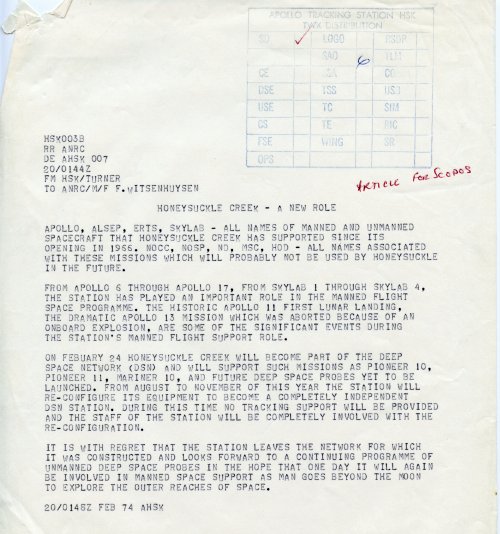 |
Honeysuckle’s new role. This piece was written for the Department of Supply’s newsletter, SCODOS. Thanks to Milton Turner. Scan: Colin Mackellar. |
Honeysuckle becomes DSS-44 in the Deep Space Network
After the highly successful and complex Skylab missions, Honeysuckle was no longer needed for Manned Space Flight Support.
Honeysuckle’s new role.
This piece was written for the Department of Supply’s newsletter, SCODOS.
Thanks to Milton Turner. Scan: Colin Mackellar.
Paraboloid
Survey of the dish for the Deep Space era – August 1974.
Hamish Lindsay writes –
“In 1974 we adjusted every antenna plate to 5 – 10 thousandth of an inch to make a true parabola for maximum signal direction to the subreflector for the Deep Space era. The feedcone was removed and my theodolite was bolted to a special bracket (seen in the photo) to measure the four corners of each plate.”
In preparation for the Paraboloid Survey, the feedcone and subreflector were removed. The second photo below was taken on 25th July 1974, and the first and third appear to have been taken at the same time.
The feedcone is about to be removed. |
25th July 1974. Down comes the feedcone. |
The feedcone is now on the ground, and the subreflector is also being hoisted away. The acquisition aid, which had been mounted at the top of the quadripod, has already been removed. |
|
Note the theodolite at the bottom of the picture. Photo: Hamish Lindsay. |
Hamish Lindsay took this photo from the Apex, looking down on John Hart with the theodolite (centre) and Tony Salvage (white overalls). Photo: Hamish Lindsay. 2022 scan: Colin Mackellar. |
|
A close up of the theodolite in position with John Hart (left) discussing the survey with Tony Salvage. Photo: Hamish Lindsay. |
|
After we left the Manned Space Flight Network the station was stripped completely bare of all the equipment and cables (except the antenna servo console seen looking lonely by the window). |
Here’s the expanded Ops console in its new location. Photo: Hamish Lindsay. Scan: Colin Mackellar. |
Here’s another, probably later, view of the DSN Ops Console. Transparency: Hamish Lindsay. Scan: Colin Mackellar. |
“A slide I took of the final Deep Space layout of the Ops area to go with the DSS pictures, after the initial layout with Laurie Turner at the console [as seen further above].
Photo: Hamish Lindsay. |
This photo is taken looking the other way, with the Servo window behind the camera. The Receivers are on the left, and the old location of the Ops Desk is at the far end on the right. Phil Maier writes, |
This transparency, also by Hamish Lindsay, shows almost the same view, once everything is in place. Scan: Colin Mackellar. |
From time
to time, Honeysuckle was called on to help with radioastronomy.
Hamish Lindsay writes –
“During the Deep Space era HSK used to fill in time helping Dick Manchester of the CSIRO to track the Vela Pulsar. To us this was very easy tracking because it was only a downlink so it was all within the USB section. PSR 0833-45, or Vela, was a pulsar in the Gum Nebula with a period of 89.3 milliseconds. The Gum Nebula is the remnant of a supernova that occured over 10,000 years ago with a diameter of 2,300 light years.”
This extract from a computer printout of Pulsar predicts for PSR B0329+54 was preserved by Geoff Ruck. Scan: Colin Mackellar. |
and Radio Astronomer Dick Manchester writes –
“Timing the Vela pulsar is interesting because the period has unpredictable ‘glitches’ every few years, where the period suddenly decreases by about a part in a million. This is actually a huge change by the standards we measure pulsar periods to. The details of the glitch and its recovery give information on the interior of the neutron star.
The NASA stations were ideal for this as you need regular observations (at least weekly) with a stable system. It was difficult to get that at Parkes as it is scheduled in bigger blocks (with bigger gaps between pulsar sessions) and has different receivers at different times. (Actually, we can now change receivers quickly with a translator system, so that is not such a big problem.)”
|
Shortly after Honeysuckle joined the Deep Space Network, this Letter of Commendation was received from Andre Caticchio at JPL. Scan by Hamish Lindsay. |